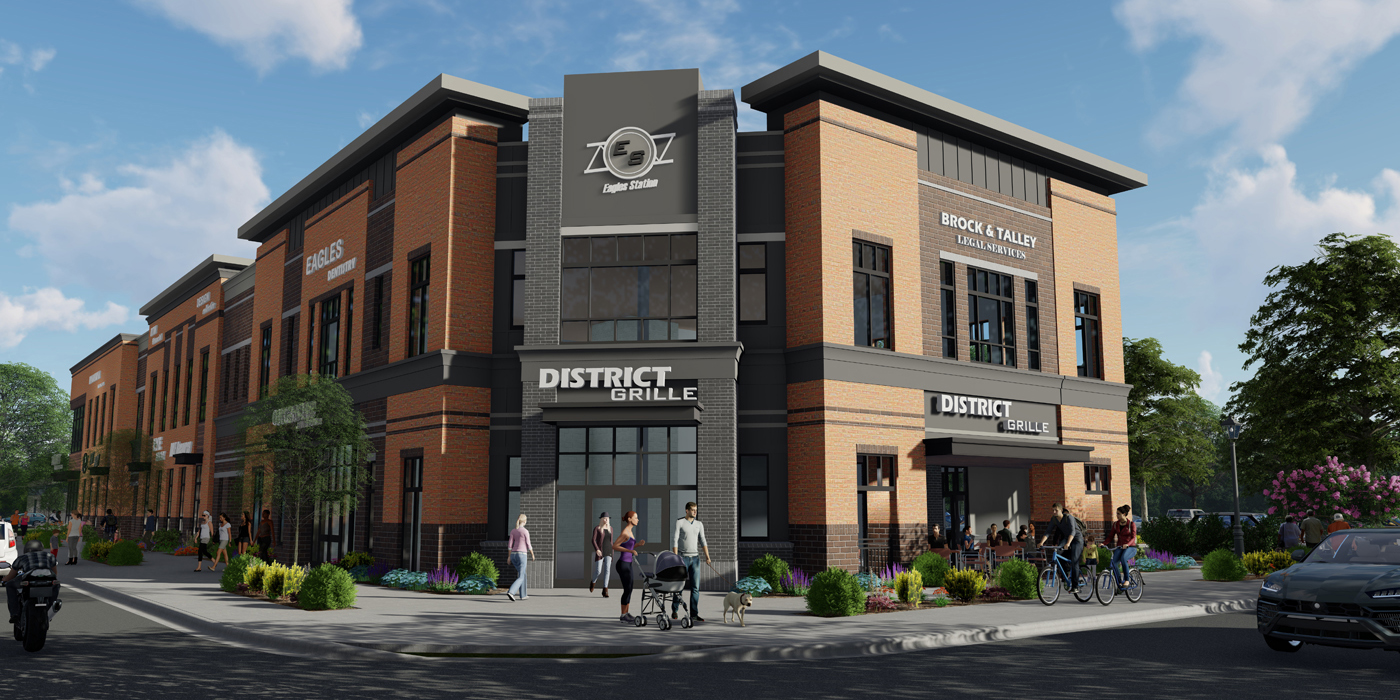Changing Expectations for commercial architects in the 21st Century
Unveiling the Comprehensive Services Offered by Commercial Architects for Modern Dope
Commercial Architects offer an essential feature in contemporary development jobs. They blend style visual appeals with capability while adhering to governing demands. Their knowledge expands past plain building and construction, integrating lasting practices and ingenious technologies. As they browse complicated zoning laws, Architects work together with different stakeholders to bring visions to life. This diverse approach questions about the progressing duty of Architects in shaping modern areas and the influence of their job on future developments.
Recognizing the Duty of Commercial Architects in Modern Developments
In modern metropolitan landscapes, Commercial Architects play an essential duty in forming useful and visual areas that satisfy diverse organization demands. Their expertise prolongs beyond simple layout; they browse complex zoning regulations, building codes, and ecological regulations. By collaborating with clients, they identify details requirements, guaranteeing that each job lines up with the customer's vision while additionally thinking about functional facets such as sustainability and cost-effectiveness. Commercial Architects are skilled at incorporating ingenious innovations and materials into their styles, boosting both the performance and power performance of structures. They carry out comprehensive website evaluations to examine the prospective difficulties and possibilities provided by an area. Additionally, efficient interaction with professionals and various other stakeholders is vital, ensuring that the project advances efficiently from conception to completion. Eventually, Commercial Architects are important in producing rooms that not just meet useful objectives however additionally add to the general character and vibrancy of metropolitan atmospheres.
Principle Design: Changing Concepts Into Truth
Idea layout functions as an essential phase in Commercial architecture, where cutting-edge style remedies arise from imaginative thinking. This process relies upon collaborative ideation, uniting varied perspectives to fine-tune and improve first concepts. As concepts take form, they change from abstract concepts into substantial building realities.
Innovative Layout Solutions
Transforming concepts into reality is the characteristic of innovative style remedies in Commercial design. These solutions blend creative thinking with functionality, attending to the one-of-a-kind needs of modern developments. By leveraging advanced innovations and lasting methods, Architects craft rooms that are not just aesthetically enticing yet also reliable and versatile. Focus on individual experience drives the style process, ensuring that settings foster performance and partnership. Each task take advantage of a customized approach, where ideas are meticulously established to mirror the customer's vision while thinking about future patterns. Cutting-edge design solutions additionally prioritize flexibility, enabling for modifications in time as business needs progress. Eventually, these methods boost the general worth of Commercial areas, making them pivotal in today's competitive landscape.

Collaborative Ideation Process
Cooperation acts as the backbone of the ideation procedure in Commercial design, cultivating imagination and innovation amongst diverse stakeholders. Architects, customers, designers, and neighborhood members engage in vibrant conversations, making sure that all perspectives are considered. This inclusive method permits the expedition of various layout concepts, motivating distinct remedies that line up with the task's vision. With workshops and brainstorming sessions, ideas advance and refine, transforming initial ideas into concrete styles. Innovation likewise plays a crucial function, with tools such as Building Information Modeling (BIM) helping with real-time partnership and modifications. Inevitably, this joint ideation process not just boosts the layout result yet likewise cultivates a sense of ownership and investment amongst all parties entailed, resulting in effective Commercial growths.
Zoning Analysis: Navigating Rules and Compliance
As developers start on brand-new tasks, understanding zoning policies is necessary to ensuring conformity and avoiding expensive delays. Zoning analysis plays an important duty in this procedure, as it includes assessing local zoning laws that determine land use, building elevation, thickness, and setbacks. Commercial Architects have the proficiency to navigate these complex guidelines, helping customers recognize permitted uses and any kind of essential variances.
Sustainable Layout Practices: Structure for the Future
Sustainable design methods are progressively vital in the domain name of Commercial design, especially as environmental issues remain to intensify. Architects focus on eco-friendly materials, energy-efficient systems, and layout methods that lessen waste and environmental impact. Incorporating renewable resource sources, such as solar panels and wind generators, permits structures to produce their very own power and lower dependence on fossil fuels.Furthermore, sustainable layout highlights the value of indoor ecological top quality. This includes utilizing natural light, enhancing ventilation, and picking non-toxic materials to boost resident health and wellness and productivity. Environment-friendly roofings and living wall surfaces are also popular functions that add to biodiversity and urban cooling.Additionally, Commercial Architects commonly integrate water conservation techniques, like rainwater harvesting and drought-resistant landscaping. Via these cutting-edge techniques, they produce spaces that not only satisfy modern requirements however also promote a lasting future, dealing with the growing need for responsible growth in the modern globe.
Job Monitoring: Ensuring Timely and Efficient Execution
Efficient task management is essential for making sure that Commercial style jobs are completed promptly and within budget plan. This duty encompasses a variety of obligations, consisting of the sychronisation of various stakeholders, timelines, and resources. Commercial Architects utilize their proficiency to create detailed job plans that detail important landmarks and deliverables, enabling organized development tracking.Regular interaction amongst staff member and customers is crucial, fostering transparency and helping with prompt decision-making. Threat management approaches are additionally used to determine prospective difficulties early, making it possible for proactive remedies to be created. By using innovative task administration devices, Architects can keep track of job efficiency in real-time, making modifications as essential to preserve performance.
Interior Design: Creating Functional and Aesthetic Rooms
Interior design plays a crucial role in enhancing both capability and visual appeal within Commercial areas. Effective room preparation can enhance operations and improve individual experience, while aesthetic style principles add to an aesthetically appealing atmosphere - commercial architects. With each other, these elements create rooms that are not just sensible however also inspiring
Space Planning Efficiency
While optimizing the utility of available room, Commercial Architects prioritize room preparation performance to develop both practical and cosmetically pleasing atmospheres. This approach entails careful evaluation of the spatial format to guarantee excellent use every square foot. Architects consider aspects such as process, access, and all-natural light to improve functionality. By strategically positioning furnishings, devices, and workstations, they assist in activity and interaction among customers, promoting efficiency. In addition, zoning different locations for particular features aids in managing noise and personal privacy, producing an unified environment. Via efficient room preparation, Commercial Architects can change restrictions right into chances, making certain that each see here now room meets the varied requirements of its owners while sticking to regulative demands and market criteria.
Visual Style Concepts
Aesthetic style principles play a necessary role in forming atmospheres that are not just useful however likewise aesthetically attractive. These concepts direct Commercial Architects in developing spaces that reverberate with individuals while enhancing brand name identity. Crucial element include equilibrium, proportion, and consistency, which work together to create a cohesive look. Color design and products are thoroughly chosen to stimulate wanted emotions and support the overall theme. Furthermore, illumination plays an essential role, affecting state of mind and presence while highlighting building attributes. By integrating these concepts, Architects see it here guarantee that rooms are not only functional but also inviting and motivating. Inevitably, efficient aesthetic style promotes a positive customer experience, urging interaction and satisfaction in Commercial environments.
Cooperation With Stakeholders: Cultivating Effective Partnerships
Successful collaborations in Commercial architecture rest on reliable collaboration with stakeholders, making sure that every voice is listened to and valued. This collective method entails interesting various celebrations, consisting of clients, contractors, and community members, throughout the style and growth procedure. By cultivating open communication, Commercial Architects can deal with concerns, gather insights, and align the job's vision with stakeholder expectations.The assimilation of diverse point of views enhances imagination and advancement, leading to even more practical and visually pleasing styles. Regular conferences, comments sessions, and workshops facilitate this discussion, allowing Architects to adjust their strategies in action to stakeholder input. On top of that, establishing depend on through openness and accountability enhances these collaborations, leading to a smoother project execution.Ultimately, the success of modern-day advancements depends upon the Architects' capability to browse and integrate differing interests, producing a collective environment that promotes shared goals and mutual success.
Frequently Asked Questions
Exactly How Do Commercial Architects Take Care Of Budget Constraints Throughout a Task?

What Types of Software Program Do Commercial Architects Commonly Utilize?
Commercial Architects typically utilize software application such as AutoCAD for drafting, Revit for Structure Info Modeling, SketchUp for 3D modeling, and task monitoring devices like Microsoft Task to enhance cooperation and improve workflows throughout the style procedure.
Can Commercial Architects Aid With Obtaining Financing for Projects?
Commercial Architects can aid in getting financing for jobs by preparing in-depth proposals, helping to articulate layout visions, and providing economic estimates that can boost the likelihood of safeguarding required financing from capitalists or banks.
Just How Do Architects Make Certain Security Throughout the Construction Refine?
Architects guarantee safety during construction by carrying out extensive style requirements, collaborating with engineers, carrying out normal website assessments, adhering to neighborhood laws, and cultivating interaction amongst all stakeholders to reduce threats and promote a secure working setting.
What Recurring Support Do Architects Supply After Task Completion?
After job conclusion, Architects offer ongoing assistance via blog upkeep examinations, efficiency evaluations, and layout adjustments. They assure structures satisfy developing requirements, address prospective concerns, and preserve conformity with laws, fostering a long-term partnership with customers.